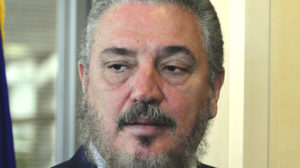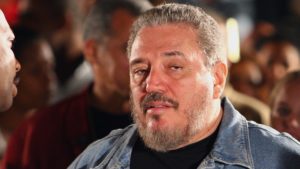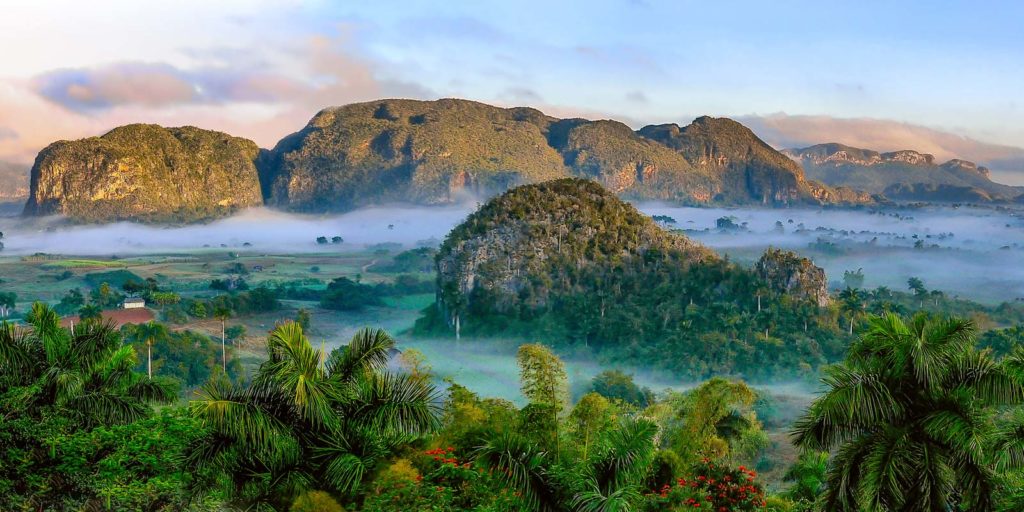FIDEL ANGEL CASTRO DIAZ-BALART, LIFE OF THE FIRST-BORN CHILD OF THE CUBAN DICTATOR. PHOTOS.
Fidel Ángel Castro Díaz-Balart, whose private life, childhood, adolescence, and youth, thanks to the halo of secrecy that his father created around everything and his family in particular, very little is known.
The reality is that Fidel Castro did not take care of anything related to his son, after removing his mother, from the Diaz-Balart lineage, somehow responsible for his being alive, out of the way, and he rarely saw him or conversed with him, and these contacts became even more sporadic as other children appeared, his wife, Dalia Soto del Valle, who jealously took care of the priority for her five children, those who had no contact with Fidelito or with others from descendants conceived by the ultimate leader out of wedlock.
It is said that for many years a Personal Security officer named Fulleda was in charge of attending to all the needs of the adolescent. This character who always accompanied him is said to have been part of a group of students who lived with him and made him the task of escort or security, at any time in his life, regardless of other characters who were there, but who were never there. so close. Contemporaries with him and faithful to the system, they were better than a battalion of expert bodyguards, since they would always be by his side, even as a student who returned to Cuba during vacation periods. Apart from this, KGB officers also supervised his security and Fidelito resided in an apartment in the Moscow capital where he had all the comforts.
LIFE OF FIDEL CASTRO DIAZ-BALART
José Raúl (the name he used during his stay in the Soviet Union) or Fidelito, graduated from Lomonosov University in Moscow and was linked to the Kurchatov Institute, a prestigious atomic energy institution in Russia. He also received a Master’s Degree in Physics, a Doctor of Physical-Mathematical Sciences, and a Doctor of Science.
In the 1980s he was closely linked to the study and development of nuclear energy for the use of it in Cuba and founded the Higher Institute of Nuclear Sciences and Technology in Havana. During those years he was in charge of the construction of the Juraguá nuclear plant, which was not finished due to the fall of the socialist camp and today is nothing more than a ruinous memory of the cooperation between Cuba and the Soviet Union.
Upon his return to Cuba in 1978, the Executive Secretariat for Nuclear Affairs was created, “la Nuclear”, as that institution was known, located on 5th Avenue and 30th Street, in Miramar, the Cuban Ministry of the Interior (MININT), created a department special for the security of both Fidelito and the newly created institute. Some of his troops were taken from the old MININT Special Troops Unit; In this way, a team of escorts and cars also emerged that accompanied him to all places.
These deferences raised a wave of adverse comments within the government leadership, but what really caused a debacle in his career was the fact that the financial state of “Nuclear” was increasingly disastrous, and his personal expenses in travel and Vacations were extraordinary, to the point that they came to compete with the administrative expenses of the institution he directed. They did not realize that Fidelito only did what he had seen his father do, but he, without being a high government official, misused and wasted as many resources as his father.
Since his arrival, he did not show himself at any time as a bitter or suspicious person because they had just dethroned him from a very high responsibility, nor did he manifest any type of negative criteria, on the contrary, making the most exquisite use of the saying “in bad weather, good weather face ”and face it all with optimism and hope, drawing all his energy to face what happened.
He never told you: We are going to do it like this, but he shared criteria about how to undertake a task, he asked for opinions and many times he tried to defeat your position to see how far you were convinced or the arguments you gave were devastating, and then accept your proposal, considering it the most rational and appropriate.
Many times I have wondered how a person who lived from his youth and was already past 60 years in a world of intrigues, misgivings, conspiracies, mistrust, could show himself as an open person, completely transparent in his approaches and a fervent enemy of gossip. .
In 2012, Castro Díaz-Balart refuted reports that Fidel Castro was becoming senile, describing his father as “lucid” and “working hard,” which was similar to Castro’s “optimistic assessment” of Castro’s health. Diaz-Balart. in February 2007, following Castro’s illness during that period.
In April 2014, he visited Russia to declare Cuba’s recognition of the annexation of Crimea by the Russian Federation, also receiving an honorary doctorate from Voronezh State University. In February 2015, during the Cuban thaw towards the end of the Obama administration, when Americans had more freedom to visit Cuba, he participated in events welcoming American celebrities to the island, mingling with Paris Hilton and Naomi Campbell. The following month, he visited Novosibirsk, Russia, and met with the mayor, Anatoly Lokot, and regional governor Vladimir Gorodetsky to improve Cuba’s relations with scientific institutions in the region.
DEATH
Castro Díaz-Balart committed suicide in Havana on February 1, 2018, at the age of 68. He had previously received outpatient care for depression. The report of his suicide by the Cuban government was described as “unusually public.” Fidel Angel Castro Díaz-Balart’s first cousin, Gabriel Díaz-Balart, had also previously committed suicide as a result of depression.
At his death, he still held positions in the Cuban Academy of Sciences and the Council of State.
PERSONAL LIFE
Castro Díaz-Balart had three children, Mirta María, Fidel Antonio and José Raúl, with Natasha Smirnova, whom he met in Russia. After divorcing Smirnova, he married María Victoria Barreiro of Cuba. US Congressman Mario Díaz-Balart, currently a representative from Florida’s 25th District, and former US Congressman Lincoln Díaz-Balart were his maternal cousins.
FIDEL ANGEL CASTRO DIAZ-BALART, VIDA DEL PRIMOGENITO DEL DICTADOR CUBANO. PHOTOS.
Fidel Ángel Castro Díaz-Balart, de cuya vida privada, niñez, adolescencia y juventud gracias al halo de secretismo que su padre creó alrededor de todo y en particular de su familia, muy poco se conoce.
La realidad es que Fidel Castro no se ocupó para nada de lo relacionado con su hijo, después de quitar del camino a su madre, de la estirpe de los Díaz-Balart, de alguna forma responsables de que siguiera vivo, y raramente lo veía o conversaba con él, y esos contactos se hicieron aún más esporádicos en la medida en que fueron apareciendo otros hijos esposa, Dalia Soto del Valle, la que cuidó celosamente la prioridad para sus cinco hijos, los que no tenían contacto con Fidelito ni con otros de los descendientes concebidos por el líder máximo fuera de matrimonio.
Se dice que durante muchos años un oficial de la Seguridad Personal de apellido Fulleda era el encargado de atender todas las necesidades del adolescente. Este personaje que siempre lo acompanaba se dice que formaba parte de un grupo de estudiantes que vivieron junto a él y le hicieron la tarea de escolta o seguridad, en cualquier momento de su vida, al margen de otros personajes que hubiera, pero que nunca estuvieron tan cerca. Contemporáneos con él y fieles al sistema eran mejor que un batallón de expertos guardaespaldas, pues siempre estarían a su lado, incluso en su etapa de estudiante que regresaba a Cuba en periodos vacacionales. Al margen de esto, oficiales de la KGB supervisaban también su seguridad y Fidelito residía en un apartamento en la capital moscovita donde tenía todas las comodidades.
VIDA DE FIDEL CASTRO DIAZ-BALART
José Raúl (nombre que usó durante su estancia en la Unión Soviética) o Fidelito, se graduó en la Universidad de Lomonosov en Moscú y estuvo vinculado al Instituto Kurchatov, una prestigiosa institución de energía atómica de Rusia. También se hizo Máster en Física, Doctor en Ciencias Físico-matemáticas y Doctor en Ciencias.
En la década de los 80 estuvo estrechamente vinculado al estudio y desarrollo de la energía nuclear para su empleo en Cuba, y fundó el Instituto Superior de Ciencias y Tecnología Nucleares de La Habana. Por esos años estuvo a cargo de la construcción de la planta nuclear de Juraguá, que no se terminó por la caída del campo socialista y hoy no es más que un ruinoso recuerdo de la cooperación entre Cuba y la Unión Soviética.
A su regreso a Cuba en 1978 se crea la Secretaría Ejecutiva de Asuntos Nucleares, “la Nuclear”, como era conocida esa institución situada en la 5ta Avenida y calle 30, en Miramar, el Ministerio del Interior cubano (MININT), creó un departamento especial para la seguridad, tanto de Fidelito como del recién creado instituto. Algunos de sus efectivos fueron sacados de la antigua Unidad de Tropas Especiales del MININT; de esta forma también surgió un equipo de escoltas y autos que lo acompañaban a todos los lugares.
Estas deferencias levantaron una ola de comentarios adversos dentro de la cúpula gubernamental, pero lo que realmente causó una debacle en su carrera fue el hecho de que el estado financiero de “la Nuclear” era cada vez más desastroso, y sus gastos personales en viajes y vacaciones resultaban extraordinarios, al punto que llegaron a competir con los gastos administrativos de la institución que dirigía. No se daban cuenta que Fidelito solamente hacía lo que había visto hacer a su padre, pero él, sin ser un alto funcionario del gobierno, malversaba y despilfarraba tanto recursos como su progenitor.
Desde su llegada no se mostró en ningún momento como una persona amargada o recelosa porque lo habían acabado de destronar de una altísima responsabilidad, ni manifestó ningún tipo de criterio negativo, todo lo contrario, haciendo el más exquisito uso del refrán “ a mal tiempo bueno cara” y afrontarlo todo con optimismo y esperanza, sacado toda su energía para hacerle frente a lo ocurrido.
Nunca te decía: Vamos a hacerlo así, sino compartía criterios acerca de qué forma acometer una tarea, pedía opiniones y muchas veces trataba de derrotar tu posición para ver hasta donde estabas convencido o los argumentos que dabas eran demoledores, para después aceptar tu propuesta, por considerarla la más racional y adecuada.
Muchas veces me he preguntado cómo una persona que vivió desde su juventud y ya pasaba de los 60 años dentro de un mundo de intrigas, recelos, conspiraciones, desconfianza, podía mostrarse como una persona abierta, completamente transparente en sus planteamientos y ferviente enemigo del chisme.
In 2012, Castro Díaz-Balart refutó los informes de que Fidel Castro se estaba volviendo senil, describiendo a su padre como “lúcido” y “trabajando duro”, que era similar a la “evaluación optimista” de la salud de Castro que hizo Castro Díaz-Balart. en febrero de 2007, tras la enfermedad de Castro durante ese período.
En abril de 2014, visitó Rusia para declarar el reconocimiento de Cuba a la anexión de Crimea por parte de la Federación Rusa, recibiendo también un doctorado honoris causa en la Universidad Estatal de Voronezh. En febrero de 2015, durante el deshielo cubano hacia el final de la administración Obama, cuando los estadounidenses tenían más libertad para visitar Cuba, participó en eventos para dar la bienvenida a celebridades estadounidenses a la isla, mezclándose con Paris Hilton y Naomi Campbell. Al mes siguiente, visitó Novosibirsk, Rusia, y se reunió con el alcalde, Anatoly Lokot, y el gobernador regional Vladimir Gorodetsky para mejorar las relaciones de Cuba con las instituciones científicas de la región.
MUERTE
Castro Díaz-Balart se suicidó en La Habana el 1 de febrero de 2018, a la edad de 68 años. Anteriormente había recibido atención ambulatoria por depresión. El informe de su suicidio por parte del gobierno cubano fue descrito como “inusualmente público”. El primo hermano de Fidel Angel Castro Díaz-Balart, Gabriel Díaz-Balart, también se había suicidado anteriormente como resultado de la depresión
A su muerte aún ocupaba cargos en la Academia de Ciencias de Cuba y el Consejo de Estado.
VIDA PERSONAL
Castro Díaz-Balart tuvo tres hijos, Mirta María, Fidel Antonio y José Raúl, con Natasha Smirnova, a quien conoció en Rusia. Tras divorciarse de Smirnova, se casó con María Victoria Barreiro de Cuba. El congresista estadounidense Mario Díaz-Balart, actualmente representante del distrito 25 de Florida, y el excongresista estadounidense Lincoln Díaz-Balart eran sus primos maternos .
Agencies/ Wiki/ MemoriasCubanas/ Carlos RodriguezB. / Extractos/ Excerpts/ Internet Photos/ Arnoldo Varona/ www.TheCubanHistory.com
THE CUBAN HISTORY, HOLLYWOOD.












